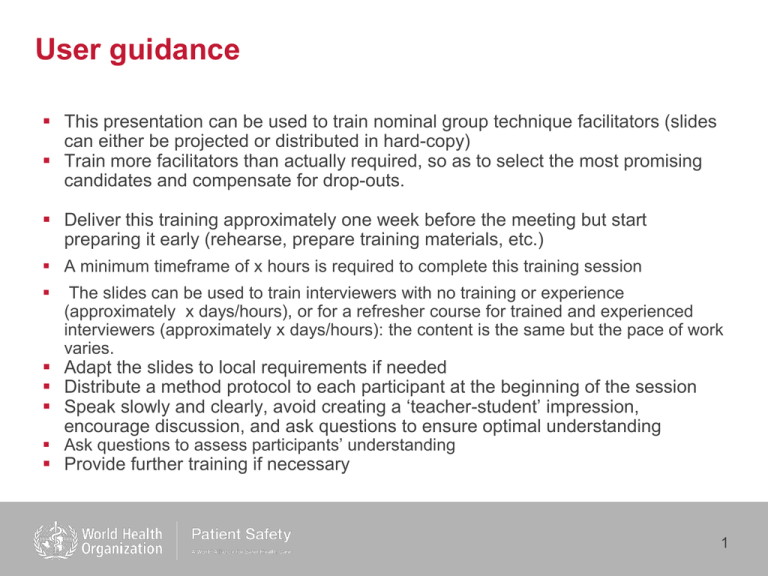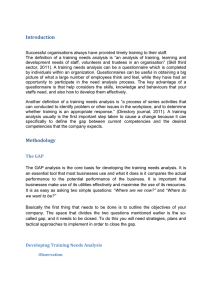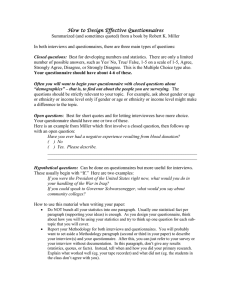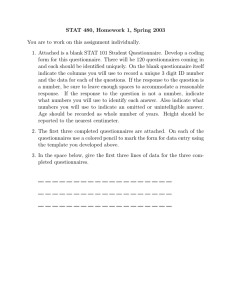User guidance
advertisement

User guidance This presentation can be used to train nominal group technique facilitators (slides can either be projected or distributed in hard-copy) Train more facilitators than actually required, so as to select the most promising candidates and compensate for drop-outs. Deliver this training approximately one week before the meeting but start preparing it early (rehearse, prepare training materials, etc.) A minimum timeframe of x hours is required to complete this training session The slides can be used to train interviewers with no training or experience (approximately x days/hours), or for a refresher course for trained and experienced interviewers (approximately x days/hours): the content is the same but the pace of work varies. Adapt the slides to local requirements if needed Distribute a method protocol to each participant at the beginning of the session Speak slowly and clearly, avoid creating a ‘teacher-student’ impression, encourage discussion, and ask questions to ensure optimal understanding Ask questions to assess participants’ understanding Provide further training if necessary 1 Slides to train observers and interviewers <insert your name, position and affiliation> 2 What and how will you learn? What: Patient safety and WHO's initiative Key concepts of patient safety The objectives and processes of nominal group meetings Your role as a meeting facilitator How to excel in your role: do's and don'ts How: Facilitator-led presentation Questions and discussions Quiz Hands-on exercise 3 What is patient safety? Freedom from accidental injuries during medical care Activities to avoid, prevent or correct any adverse outcomes which may result from the delivery of health care 4 Why is patient safety important? Every year tens of millions of patients suffer disabling injuries or death due to unsafe medical care In developed countries 1 in 10 patients is harmed while receiving hospital care We know little for developing countries but evidence suggests that they are even more affected by patient harm The consequences are millions of devastated lives and billions of dollars unnecessarily spent on prolonged hospitalization, loss of income, disability and litigation 5 The initiative of the World Health Organization Against this backdrop, the World Health Organization called into life the World Alliance for Patient Safety in 2004 The Alliance pays particular attention to patient harm in developing and transitional countries Since fact-based knowledge is often rare in such contexts, the Alliance has developed simple methods to help local practitioners and researchers assess and tackle patient harm in data-poor environments You can contribute to successfully conducting one of these methods by acting as a nominal group meeting facilitator 6 What is direct observation? Why: either to identify causes of HIs occurring during injection giving/problems relating to injection facilities and supply stock, or to monitor and improve achievements What: observation of injection facilities and supply stock, and of injection practices Who: observation is conducted by trained observers How: observers use questionnaires to guide observation, and results tables to condense results How long: thee investigators need half a day to conduct direct observation and interviews for five wards/departments of a district hospital 7 What are interviews? Why: either to identify problems relating to injection practices/injection facilities and supply stock, or to monitor and improve achievements What: interviews with injection givers and their department supervisors Who: interviews are conducted by trained interviewers How: interviewers use questionnaires to guide the interviews, and results tables to condense results How long: thee investigators need half a day to conduct direct observation and interviews for five wards/departments of a district hospital 8 Your role: prepare observation/interviews* 1. Principal investigator only studies method protocol, questionnaires and key success factors presents project objective to facility anagers/stakeholders, receives approval and explains how they can support the project agrees with facility managers on which wards/units will be assessed and when selects and trains observers and interviewers 2. All investigators study method protocol, questionnaires and key success factors prepare to explain and conduct the observation/interviews clarify questions and make necessary arrangements (availability of staff, questionnaires, etc.) * More comprehensive guidance is provided in the method protocol 9 Your role: conduct of observation/interviews* 3. Introduction present objective of assessment to matron, explain how she can help, be introduced to staff from participating clinical areas, and help her explain that: no disciplinary measures will be taken against staff if unsafe injection practices are discovered names are not recorded on the data collection sheets staff have the right to refuse participation objective is to improve healthcare provision, not to assess observed individuals 4. Fill in questionnaires and results tables observers complete a questionnaire based on observation of facilities and stock (questionnaire 1) and one on injection practices (questionnaire 2) interviewers complete a questionnaire based on interviews with healthcare workers (3.a) and one based on interviews with department supervisors (3.b) team fills in results tables based on information contained in questionnaires *More comprehensive guidance is provided in the method protocol 10 Your role: conduct of observation/interviews* (continued) 5. Compare results tables of the current assessment to those of past assessments (if the objective is to monitor and improve the results of previous assessments only) if same wards have been analysed: discuss with department supervisor so as to identify in which areas progress has/has not been achieved, and for what reasons If different units have been analysed: discuss with department supervisor so as to identify whether observed HI problems relating to injection facilities and supply stock are the same or differ Agree with department supervisor on improvement measures and when/how to re-assess the situation 6. Conclude Observations/interviews ensure that questionnaires/results tables are fully and clearly completed • thank involved staff, explain next steps, provide contact details and present results to facility managers if possible *More comprehensive guidance is provided in the method protocol 11 How to excel in role as an observer: do… discuss with the principal investigator any parts of the questionnaire you are unclear about observe closely and note as precisely as possible, and only once the care-giver has finished an action put yourself in an open frame of mind, so that your observations are as free of opinions and bias as possible be aware that observed care-givers may perform their work differently or better when being observed try to reduce the stress that observation places on observed care-givers stop observing if a care-giver does not wish to continue the assessment answer questions that observed staff may raise at the end of the observation (unless this could expose an injection recipient to risks) focus on what is asked in the questionnaire, rather than writing down everything you notice 12 How to excel in role as an observer: don't… forget that the primary objective is to assess the situation and not to teach staff how to do things forget to refrain as much as possible from interacting with a care-giver, but do interrupt him/her if he/she is about to expose an injection recipient to substantial risks draw attention to your observer role; to avoid influencing the environment you observe be as discreet as possible let your note taking get in the way of observing what nurses are doing: first observe, then take notes wait to clean up and complete your notes after the observation, or you will forget information 13 How to excel in your role as an interviewer: do... discuss with the principal investigator any parts of the questionnaire you are unclear about conduct the interviews in a calm environment and avoid interruptions allow time to build a relationship of trust with the respondent inform respondents that the objective is to improve injection practices and availability of equipment, and not to test individual care-givers follow the questionnaire as much as possible, but provide further explanations if needed speak slowly and use understandable language leave respondents enough time to think 14 How to excel in your role as an interviewer: don’t... be nervous: the respondent is probably more nervous than you forget that the primary objective is to assess the situation and not to teach staff how to do things pressurize respondents or try to influence their answers ask ‘leading questions’ (e.g. ‘You changed the steriliser safety valve last month, didn’t you?’) ask embarrassing or unnecessary questions conduct the interview in the presence of respondents’ colleagues, whenever possible (social desirability bias) let your note taking get in the way of listening to the respondent: first listen, then take notes wait to clean up and complete your notes after the interview, or you will forget information 15 Questions? Comments? 16 Quiz Instructions Not a pass/fail test but an opportunity to identify areas that require further discussion or training Participants discuss the questions in small groups (you can use your method protocol), followed by each group presenting its answers and a general discussion led by the facilitator and aimed at clarifying potential questions Questions Explain the concepts of patient safety, HIs, preventability and contributing factors in your own words and give examples for each Summarize the objective and process of a nominal group technique meeting Describe the tasks you will be performing step-by-step Discuss how to best ensure that the do‘s and don‘ts are respected 17 Hands-on exercise simulation of direct observation 1. Participants split into small groups. One participant in each group simulates the injection giver (trainer provides the necessary equipment or injection giver orally explains every step he would conduct), and other group members observe and take notes (based on questionnaire). 2. Participants change roles so that everybody acts both as injection giver and as observer. Once all observation-based questionnaires are completed, the team fills in the results tables together. 3. The trainer animates a discussion on the results, problems and lessons learned, and answers any questions participants might have 18 Hands-on exercise: simulation of an interview 1. 1. Participants split into small groups. In each group, one participant acts as interviewer, another as respondent, and the rest of the group observes the role-play. The interviewer asks questions (based on the questionnaire) and the respondent answers these. 2. 2. Participants change roles so that everybody has acted as interviewer and as respondent. Once all interview-based questionnaires are completed, the team fills in the results tables together. 3. 3. The animates a discussion on the results, problems and lessons learned and answers any questions participants might have 19 Further information For further information, questions or comments contact <insert your name and telephone number or email> Visit the Patient Safety Programme (Research) website at: http://www.who.int/patientsafety/research/en/ 20



